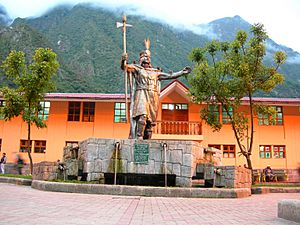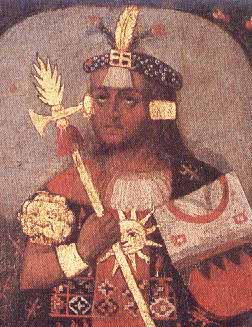Sapa Inca facts for kids
The Sapa Inca was the powerful leader of the Inca Empire. The words Sapa Inca mean "The Great Inca" or "The Only Inca" in Quechua, the language spoken by the Inca people.
According to ancient stories, the very first Sapa Inca was Manco Cápac. He lived around 1200 CE. Legend says he was the son of Inti, the sun god. Manco Cápac became the Sapa Inca after a god sent him on a journey. His mission was to find the perfect spot for a city and build it. He founded the city of Cuzco and brought together the different tribes living nearby.
Contents
What Was a Sapa Inca?
The role of Sapa Inca was passed down from father to son. This means it was a hereditary position. The Sapa Inca had complete and total power over the Inca people. Whatever he said became the law. He was also the top commander of the entire military.
The Sapa Inca lived a very rich and luxurious life. He had many wives, servants, and lots of valuable treasures. When a Sapa Inca died, his body was carefully prepared. It was then mummified, which means preserved like a mummy.
How the Inca Empire Grew
The Inca Empire became very large and strong under its leaders. It reached its biggest size when Huayna Capac was the Sapa Inca (from 1493 to 1527). At that time, the empire stretched from what is now Argentina all the way to Ecuador.
However, much of this growth happened before Huayna Capac. Tupac Inca Yupanqui, who ruled from 1471 to 1493, expanded the empire greatly. He conquered the Kingdom of Chimor, which was a big rival to the Inca. He also added lands in modern-day Ecuador, Peru, and Bolivia to the empire.
The Last Sapa Incas
Atahualpa was the very last Sapa Inca before the Spanish arrived. He was killed by the Spanish invaders in 1533. After Atahualpa, the Spanish put several other people in the role of Sapa Inca. These leaders were under Spanish control.
The last person to hold the title of Sapa Inca was Tupac Amaru. He was also killed by the Spanish in 1572. This marked the end of the Sapa Inca's rule.
Images for kids
See also
 In Spanish: Inca para niños
In Spanish: Inca para niños




